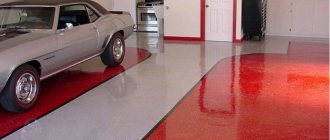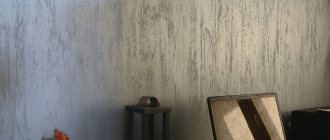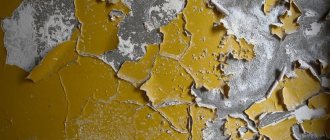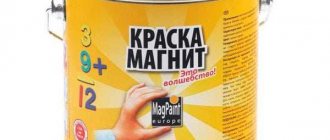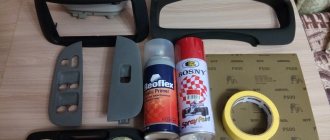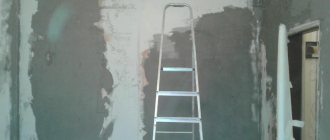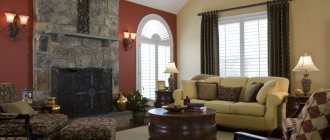Garage paint and room operating conditions
Before deciding what to paint the walls in the garage, you need to consider the conditions in which certain paint coatings will be used.
Namely:
According to statistics, only 5-7% of garages are heated on a regular basis. All other rooms are either heated from time to time or used without heating at all.
What kind of garage paint can be used here? More on this below; If there is no heating or heating is irregular, mold may form - the likelihood of its occurrence is high; Because of this, it is important that paints and varnishes contain special additives (we are talking about bactericidal components); Or, before applying paint, the surface of garage walls is carefully coated with special compounds with an antiseptic effect.
What else should you pay attention to before painting the walls in your garage?
The walls have already been puttied - soon it will be possible to paint the garage
A garage is a room where no one really cares about perfect cleanliness. Accordingly, there may be dust, dirt, even soot (the car is warming up, exhaust gases are coming out).
Besides:
- If cleaning is carried out regularly, then it is necessary to select coatings for garage walls that will cope well with abrasion - both during wet and dry cleaning;
- When choosing a composition for future painting work in garages (and other similar premises), remember that the walls here are usually built of concrete;
- This must be taken into account when purchasing any paints and varnishes, as well as when there are plans to carry out preparatory work before renovating the garage.
What do you usually choose to paint the walls in the garage?
Pentaphthalic enamels
Some people choose enamel for such rooms
The simplest option is pentaphthalic enamels. Paints of the type PF 115 are applied to the concrete surface, which has been primed in advance. Even taking into account the fact that it is inappropriate to use pentaphthalic enamels on a concrete surface, it should be noted that such compositions are often used in our time, they only show themselves on the positive side.
Why is this happening? Here's the thing:
- When the garage is closed, the sun's rays practically do not penetrate here. Consequently, the coating that is formed from the use of enamel cannot fade over a long period of time. That is, such paint for a garage is an excellent choice;
- Moreover, on the surface of the garage walls, the enamel creates a high-density hydrophobic film, so that mold, like fungus, practically does not appear here - such an environment is not suitable for their life.
Water-based coatings
Water-based coatings are also very popular for garages
The next option that many people choose for painting garage walls is water-based facade paints.
If you are thinking about the best way to paint the walls in the garage so that the result is truly durable, pay attention to the facade type of water-based compositions - this option can be very successful for a garage space
The bottom line is that such paints and varnishes have the following qualities:
They are very resistant to abrasion; Reacts well to sudden temperature changes; They are resistant to excess humidity (which is important for an unheated garage); You can easily carry out both dry and wet cleaning - without any damage to the appearance and integrity of the coating; The range of color options is impressive; The coating is antistatic (due to this, dust will stick to the walls to a lesser extent, which is very important for any owner).
Garage painting
The work of painting a garage consists of several stages: selecting tools, preparing the surface and applying paint. You should also take into account the peculiarities of painting concrete and metal surfaces.
Tools for work
Paint is applied using one of three tools:
- With a roller. Used for processing smooth surfaces over large areas. Depending on the type of paint, the type of roller is selected. For example, a foam roller is best suited for an aqueous dispersion, and a fur roller with medium-length pile is best for a water-emulsion dispersion.
- With a brush. Used for painting raised and small surfaces. Brushes are often used to work with paints and materials based on organic solvents.
- With a spray gun. The main advantage of the spray gun is the speed of work. Where it would take hours to work with a brush, you can apply paint in a few minutes using a spray gun. Among the modifications of spray guns for painting a garage, those models that are able to work with dense compositions are most suitable. The nozzle of such modifications should have a larger diameter compared to the others, this will allow denser paint to be sprayed freely. However, a spray gun is a solution that is not available to everyone due to the high cost of the equipment.
List of basic tools for painting a garage
Painting a concrete surface
Concrete has a porous surface, and therefore requires a special approach when applying paint. To achieve a high-quality result, you will need to apply three or even more layers. To reduce the consumption of paints and varnishes, a special primer for concrete is required.
Note! The optimal time for painting concrete works is summer. Paint cannot be applied at temperatures below 10 degrees Celsius. At lower temperatures, the coating will take a long time to dry and will not gain the necessary strength.
Instructions for performing the work:
- We clean surfaces from dust and dirt.
- Apply the primer with a roller and wait until the surface is completely dry.
- Stir the paint and varnish material, add the necessary pigments and solvent to it.
- We will need another small container into which we will dip the roller before applying paint to the surface.
- When the roller is well saturated with paint, remove excess paint from the side and begin painting.
- If we are talking about a wall, we paint with vertical movements - from top to bottom.
- We paint raised areas and small elements with a brush.
- After finishing work, it is recommended to leave the garage door open for some time: this will allow the paint to dry faster. If you need to leave, it is advisable to leave the heater on. Thanks to dry and warm air, the coating will dry faster.
Metal painting
- First of all, remove the old paint layer. For this purpose you will need a metal brush, a hair dryer or an electric drill with abrasive.
- Sand the surface using sandpaper.
- Degrease the metal. To do this, we use an organic solvent.
- Apply 2-3 layers of primer. This will help improve the adhesive properties of the surface and prevent rust.
- When the primer layer has dried, remove dirt and dust from the surface.
- We apply the paint with a roller, as in the case of concrete, painting from top to bottom.
- We wait 24 hours for the coating to dry. Then we apply the next layer, but horizontally.
So, when choosing paint for a garage space, you should consider the material from which the building is constructed. You also need to take into account the operating characteristics of the premises and the climatic characteristics of the area.
Source
Painting garage walls
One of the best options for painting walls are silicate paints and varnishes, which are made from potassium glass. Such materials have all the advantages listed above, that is, they are resistant to abrasion, durable and do not fade. The products are very well suited for painting garage walls, as they are often used for application to concrete, brick, stone and plastered surfaces.
Polysilicon compositions based on silicate resins are very popular. The advantage of such paint is that they adhere perfectly to organic plaster. Also, such paints retain moisture and allow air to pass through. Of course, such paint has one serious drawback - its high cost. Not everyone can afford this type of paint.
However, painting the inside of the garage with water-based paint is the most popular nowadays. This material repels dirt and dust, however, it is not used for application to lime and silicate surfaces.
As for the painting process, it is simple; even a novice builder or a person who does not have special skills in this work can cope with such work. What does this work include?
- Remove old peeled paint.
- Prime the surface. Thanks to this, you will achieve better adhesion, and material consumption will be significantly reduced.
- Apply the first coat of paint, however, after it has dried, apply the second coat, which will be the last. If you apply more than three layers of paint, you will cause the paint to begin to flake off, which will significantly shorten its service life.
Advice! Do not neglect the temperature conditions indicated on the paint can, otherwise the paint will swell and a lot of drips will be visible during its application.
Preparatory work
Painting the inside of a garage involves a number of preparatory works. Initially, you need to prepare the walls by removing the old decoration. Then they are primed.
Initially, you need to prepare the walls by removing the old decoration.
Stages of preparation of brick and concrete surfaces
First, the walls are inspected for unevenness and chips. Then all cement stains are removed. Check the quality of the brick plaster. If necessary, loose elements are fixed using a cement-sand mixture. The seams are filled with cement mixture.
Oil stains should be removed as they will bleed through the paint over time. If possible, the walls are washed or at least vacuumed.
If possible, the walls are washed or at least vacuumed.
Stages of preparation of metal surfaces
The old coating is removed from the surfaces using a suitable method. Then, solvents are used to remove oil stains. Rust is removed with a special remover. Irregularities are eliminated with metal putty.
Rust is removed with a special remover.
Stages of preparing wooden surfaces
The old coating is removed. The surface is degreased, and the existing depressions are sealed with a special wood putty. Then, the surface is sanded, cleaned of dust and primed.
The surface is degreased, and the existing depressions are sealed with a special wood putty.
Painting the walls in the garage
You can apply paint to the prepared layer of plaster. But keep in mind that this is a cheap option. Since plaster is a dark color, the paint on the wall will be darker. There is a little trick: you can make the paint thicker, or apply it in a few words to achieve the desired color. However, if you are a true connoisseur of beauty, then it is better for you to putty the walls, making them white. Then the paint will adhere perfectly and have its own bright color.
What can we say about choosing a color for the garage walls? In general, the garage is a dim room with insufficient daylight. To prevent it from being so dark and gloomy, you can choose light colors, making the garage more interesting. For example, choose from this list:
The only drawback of this finish is the soiling of the coating. If you repair cars in the garage, the walls will be quite dirty. This is why you need to use washable compounds. As for dark shades, they will put pressure on you without improving your mood. But the question arises, how to paint the walls in the garage? We mentioned that the paint must meet the requirements: not burn, not absorb moisture, withstand aggressive environments and be easy to maintain.
Dyeing process
Following simple “steps” will help make the process easier. By following these recommendations, you can save material consumption:
- The base layer should not be thick;
- Painting begins from any of the corners.
Paints based on polyurethane or alkyd resin are applied in strokes, which are then rubbed over the surface.
Painting begins from any of the corners.
Selection of paint and varnish material
Previously, it was easier to choose paint, since the assortment was scarce. There are many paints on store shelves today, but not all of them can be used on concrete. It all depends on the operating conditions. Having considered the features, advantages and disadvantages, you can choose what to paint your concrete floor, ceiling or walls.
Oil-based paints and varnishes
The products are made on an oil base. It has long been used for painting interior and exterior surfaces. However, due to the toxic composition due to solvents, it is better not to use it inside. Has a pungent odor. Advantages:
- Affordable price.
- Withstands the negative impact of the street, is not afraid of moisture and other atmospheric factors.
- A durable and beautiful coating is created.
- Oil-based paint can be susceptible to dust and dirt, but it is easy to clean with gentle products.
- Long service life.
- Good adhesion.
- Large selection of colors.
Flaws:
- Strong smell. Requires waiting for weathering before moving in.
- Toxicity.
- Long drying time, 24 hours or more.
- Has low elasticity, if the concrete cracks, the paint will tear.
- The color is unstable. The drying oil will turn yellow as it is used.
To conclude, oil paint for concrete walls is good if you need to repaint a storage area or other exterior surfaces. After all, it is cheap and practical. But it is better not to use it for work around the house or garage.
Water based paint
Water emulsion and dispersion are an excellent option for interior painting. It is water-based, so it has many advantages. There are no harmful substances in the composition. It can be used to paint concrete walls, ceilings and interior floors. There are façade paints for exterior use. The packaging indicates for what purposes the composition can be used.
Advantages:
- Environmentally friendly.
- Not afraid of moisture.
- Dries quickly.
- Has no smell.
- Easy to use.
- Paints can be sold in white and tinted by hand.
As for the disadvantages, the only thing we can note is the cost. It is low, but oil formulations are cheaper.
Acrylic paint
A universal option, it can be used to paint concrete ceilings, floors, walls inside and outside. It is based on acrylates, which give the composition special properties. The packaging indicates for what purposes it is used: “Ceiling”, “Facade”, “For walls”. Acrylic compositions are also used for artistic painting.
Advantages:
- Environmentally friendly.
- Not afraid of mechanical impact.
- Elastic.
- Vapor permeable, the walls will breathe without condensation.
- Has a stable color throughout its entire service life.
- Possibility of tinting.
- Long service life.
- Not afraid of moisture.
The downside is the cost. It is high. But if you consider the benefits, the price is justified. When choosing what to paint a concrete wall with, you can safely buy alkyd compounds.
Silicate based
It is also called glass paint, as it is based on liquid glass. Thanks to this, a durable film is created on the surface after painting, protecting the structure of the concrete surface. Suitable for indoor and outdoor surfaces.
Advantages of silicate paints:
- Not afraid of chemical exposure.
- Has stable color.
- Strong and durable.
- Protected from fire.
- Not afraid of moisture.
- Resistant to biological factors (development of mold and other microorganisms).
- Very wear-resistant.
Their disadvantages are that they are expensive, and contain toxic substances, so when working with them, it is important to take care of respiratory protection
Impregnations for concrete
Painting walls requires preparation. Before the process, it is better to coat the surface with a special impregnation. This will preserve the surface from dirt, moisture and aggressive environments. The impregnation will penetrate the concrete structure and strengthen it. The compositions are made on an acrylic base, polyurethane or epoxy resins. In addition, preliminary application will reduce paint consumption. After all, concrete has a porous structure and absorbs liquids well.
After applying the impregnation, the wall will dry in a few hours (exact time on the packaging). After this, the wall, floor or ceiling will be ready for painting. The impregnation itself is transparent and may also have additional properties, for example, antiseptic. Having considered the features of paints, you can choose what to paint your concrete floor with.
Preparing the car surface before painting
Having prepared the garage for painting work, you should move on to preparing the car itself. First of all, you need to thoroughly wash and dry the car, and, if necessary, carry out repair work.
Removing paintwork
To remove old paint and varnish coatings, mechanical and chemical methods are most often used.
For mechanical cleaning, tools are used: scrapers, metal brushes, scrapers, emery stones. The mechanical method is the simplest, but it is labor-intensive and inconvenient in hard-to-reach places. Rinse-off compositions are used for preliminary softening of durable paint and varnish coatings.
Auto repair plants use the method of immersing the body in a hot caustic solution and then rinsing it with hot water. To remove coatings from certain parts of the body, car enthusiasts use washes based on organic solvents.
You can prepare the simplest wash yourself. Dissolve 10 parts of finely planed paraffin at 70-80 ° C in 45 parts of xylene. After this, cool it to 45-55 ° C and, while stirring, add 45 parts of acetone. Cool the mixture to room temperature.
Preparing the wash is a fire-hazardous process, so it must be done in a water bath and not over an open fire.
Degreasing and putty
Before applying the primer, any uneven areas or dents on the surface should be filled. To eliminate deep defects, use a fiberglass-based product. Before application, it is necessary to clean the area with sandpaper and degrease with a solvent.
After this, sanding is done using a grinding machine or sandpaper. They degrease the car with a solvent and obtain an ideal surface on which primer and paint can be applied.
Padding
Scheme of painting work.
The primer is used to prevent corrosion, improve adhesive properties and level out small irregularities. Before application, the primer is filtered and the working surface is degreased.
Priming is done with a spray gun. First of all, the putty areas are primed, and then the entire surface is coated in several layers. Each layer must be thoroughly dried before applying the next. Avoid smudges and uneven spots when priming as they will be visible after painting.
Tools for work
When painting walls, you need to choose convenient and versatile tools that will speed up the application of paint. They are selected depending on the type of surface:
- It is better to work on plaster with non-contact tools;
- Paint can be applied to smooth surfaces using rollers and brushes.
The most popular are:
- paint brushes;
- spray gun;
- roller
Each of them has operating features and technology requirements.
Spray gun
Such tools are convenient for processing large areas. However, at the beginning of the work, care should be taken to protect furniture and vehicles from splashes. The easiest way is to remove everything unnecessary from the garage. If this is not possible, it is fashionable to cover everything with polyethylene.
The main advantage of using a spray gun is the uniform application of paint and filling of small defects (cracks or large pores).
When choosing a tool, check the following parameters:
- nozzle width;
- inlet pressure;
- torch size.
The latter is selected for a certain type of paint:
- for liquid primers, 1.3 cm is sufficient;
- for acrylic paints – 1.4 – 1.5 cm;
- for polyurethane or alkyd the parameter is 1.7-1.8 cm.
Spray guns are produced by many companies, so they differ in appearance and application technology.
Paint roller
The most popular option for painting a garage is a roller. With its help, paint is applied evenly over large areas. An option with different pile lengths is selected for each surface. For smooth surfaces, a roller with a short pile is suitable; for applying to drywall, it is better to choose models with a medium length of pile, and for embossed surfaces you will need a roller with a relief.
Paint brushes
Paint brushes are still considered a common option. They are suitable for small and hard-to-reach interior parts: frames, baseboards, corners and edging. Brushes are convenient for painting narrow partitions and other products.
The brush should be dipped no more than a third into the jar. This will help preserve the bristles and use the brush in the future.
Useful tips from the experts
When carrying out work, you should take into account the advice of professionals. They read:
- The first layer of paint can be used in a more liquid concentration.
- Work should begin from the corner.
- To speed up the application of paint, several strokes of paint are applied to the surface, after which they are rubbed using a roller or brush.
- The strokes should be parallel to the grain.
- When painting with a spray gun over the entire surface of the area, the distance between the tool and the wall should be uniform.
- Before mixing paints, you need to study the instructions on the composition.
Painting the walls of the garage allows you to provide an attractive appearance and provide the necessary level of protection of the structure from the negative influence of the external environment. The main thing is to choose the right paints and follow the technology for applying them.
Painting concrete walls
You might end up with something like this - a comfortable garage
Now is the time to decide the following: how to paint the walls in the garage, and how it should be done if the walls themselves are made of concrete.
As for the materials, the same garage paints that were listed and discussed above will be used here, but in addition to them, be sure to also use deep penetration impregnation!
Why is impregnation needed?
- The secret is that concrete has a porous surface, so the paint and varnish material will apply completely unevenly;
- You will have to paint the wall in the garage in several layers to get a satisfactory result;
- To ensure that paint consumption is within the normal range (unjustified waste of paint and varnish materials is unlikely to please anyone), you can do the right thing - use a specialized primer specifically for concrete surfaces.
Consider the following point - it is best to carry out painting work in an unheated garage when it is a warm season outside, that is, the temperature does not drop below plus 10 degrees.
If painting is done in low temperatures, then the coating that you applied to the garage walls will take a long time to dry. At the same time, it will never be able (which is more than likely) to gain the necessary strength. This should not be allowed, so that repairs do not have to be started again after some time.
Stages of work
In what order is painting the walls in the garage done? Now we will analyze literally every step that you need to complete if you undertake this work yourself.
First you need to put things in order - it is recommended to remove dust from the walls. The simplest broom is ideal for this; When cleaning of the surface to be treated is done, apply the primer with a roller. The same “Betonokontakt” or something similar will do. After application, wait until the composition dries completely; Stir the paint thoroughly, while adding solvent or pigments to its composition - this is all described in the instructions for the paint and varnish material. That is, just read the manual and act as it says
It is better not to allow deviations in such an important matter;
Painting garage walls in progress
- Some paint is poured into a small paint bath and a roller is dipped into it. When the roller has absorbed the required amount of paint, remove it, remove all the sagging on the side - and you can begin the painting work itself. It's time to paint the garage walls!
- Painting a wall is easy. Just apply vertical stripes. If you are painting the ceiling, it is recommended to place the stripes first along, then across, so that the paint is smeared thoroughly;
- When painting is finished, it is better not to close the garage door tightly for some time - this will allow the coating to dry faster. And if you still need to lock the gate, install a heater in your garage (a mobile version will do).
After painting the walls, the heater is installed to ensure that the room has an optimal temperature and the air remains dry within the required limits.
To eliminate possible questions, we recommend that you watch the video - how to paint the walls in the garage
Be sure to watch this video so as not to make annoying mistakes and have a clear idea of how work of this level is performed.
Now you can paint the walls in your garage without any problems - the preparation is complete
We figured out what can be used to paint the walls in the garage, and also looked at the order in which such work is carried out. Now you can safely begin painting work in your premises - and very soon the garage will be equipped exactly the way you want it. There is nothing complicated here - the most important thing in such work is that you have your desire and the necessary tools/paint materials at hand.
How to paint?
Before painting surfaces, they need to be prepared:
- Remove the previous coat of paint if it is cracked, peeling or loose, as the paint on such a floor or wall will not last long.
- Thoroughly clean the surface, ensuring its evenness and strength.
- Apply, if necessary, a layer of primer, which will reduce surface adhesion and provide dense coverage with the coloring composition.
Attention
Treatment with special agents against condensation, the appearance of fungus or mold, and preparation for painting will significantly reduce paint consumption. This is true when choosing expensive paints and varnishes.
If the paint is applied in several layers, then each of them must dry well until a durable film is formed. This will protect against the appearance of unpainted marks, stripes, and other defects.
Regardless of the type of paint, it must be applied at a temperature of 10 ° C, and the garage must be equipped with a heater to allow the film to dry quickly.
By refusing the help of experts, following simple instructions, you can save your money.
On your own, you can paint the walls not only in the garage, but throughout the entire apartment: in the kitchen, dining room, bedroom, hallway, living room, bathroom and toilet.
Brick and concrete surfaces
Preparing and painting walls made of concrete and brick requires preliminary leveling and painting of all subsequently treated surfaces.
Instructions for painting concrete and brick walls in a garage:
- Inspect the surfaces, mark areas with potholes and defects.
- Sagging, stains or drip protrusions are removed with a chisel and hammer, metal spatula or trowel.
- After checking the strength of each brick or block, it is necessary to seal the problem areas with a solution of sand and cement.
- All deep seams between masonry elements must be filled with this solution, followed by jointing after 2 hours.
- Efflorescence is removed using special means (not vinegar or popular recipes).
- No amount of paint will hide oil stains. They need to be knocked down, going a few millimeters deep.
- Leveling and cleaning the surface is carried out with a drill with brush attachments, water-abrasive car washes or soft blasting using a high-pressure air jet.
- The surface is dried naturally or dusted with a vacuum cleaner or rags.
- Apply the primer in an even layer using any convenient tool.
- Painting is done using selected types of paints and tools.
Read more about how to paint a wall made of brick, as well as gypsum tiles and decorative stone here.
For plaster
It is necessary to paint the internal surfaces and façade of the garage in warm seasons - this will ensure better coating quality, ventilation, and prolong the service life.
Important
Important: any plaster is more porous than a solid metal, concrete or brick surface. This must be taken into account when calculating the amount of paint.
Instructions for painting plastered walls in a garage:
- If possible, remove dirt, dust and any unevenness or foreign inclusions from the surface.
- Chips, small cracks or other defects must be puttied, dried, leveling the surface to be painted (how to putty and evenly paint walls?).
- Dry all surfaces, coat with primer, dry the walls again for 6-12 hours (depending on the type of composition used. Manufacturers indicate this information on the packaging). This improves adhesion to the base paint.
- Prepare paint and varnish material. Adding color requires thorough mixing of the mixture to ensure uniformity of the original color.
- Depending on the painting tool, follow the application technology when starting painting.
- To coat hard-to-reach places and corners, you need to use a special round brush (if you are not using a spray gun).
- Apply one or more times as needed to achieve the desired color effect. Each layer must be completely dry to avoid streaks or other unevenness.
The painted room must be thoroughly ventilated, regardless of the type of paint used.
Color selection
Not only the appearance of the interior space of the garage depends on the color, but also the mood of its owner, who sometimes has to spend a lot of time in this room.
Proper selection of the color of the garage walls will help visually change the dimensions of the building. Typically, the garage is a dim space with minimal sunlight. Therefore, painting in light colors is considered optimal.
To hide minor stains, you should paint the lower zone in a dark shade, and the upper zone in a light shade. Psychologists do not recommend using gray tones in decoration. It is better to give preference to yellow and red. They will help increase efficiency and concentration on details.
Painting concrete walls
You may end up with something similar - a comfortable garage
Now is the time to decide the next thing - how to paint the walls in the garage, and how it should be done if the walls themselves are made of concrete.
Why is impregnation needed?
- The secret is that concrete has a porous surface, so the paint and varnish material will apply completely unevenly;
- You will have to paint the wall in the garage in several layers to get a satisfactory result;
- To ensure that paint consumption is within the normal range (unjustified waste of paint and varnish materials is unlikely to please anyone), you can do the right thing - use a specialized primer specifically for concrete surfaces.
If painting is done in low temperatures, then the coating that you applied to the garage walls will take a long time to dry. At the same time, it will never be able (which is more than likely) to gain the necessary strength. This should not be allowed, so that repairs do not have to be started again after some time.
Features of painting on plaster
The process of preparing previously plastered surfaces is similar to the pre-treatment of any others. All uneven surfaces are also puttied. Then the surface is dried, a layer of primer is applied, after which the walls must dry well for at least six hours.
Taking into account the porosity of the material structure, paint consumption for treating plastered surfaces doubles.
The surface is dried, a layer of primer is applied, after which the walls must dry thoroughly for at least six hours.
How to choose the right coating
If the garage is unheated, facade (for external work) paints are used for interior decoration.
- An expensive, but most reliable method is the use of polyurethane or alkyd-urethane enamels. They are applied with a roller or brush at temperatures from -10°C to +35°C. If the surfaces of the walls and floors are not leveled, not plastered, or have chips and gouges, paint is applied in 2 layers.
- A budget-friendly, but no less reliable way is to use water-based acrylic compounds. They have only one drawback: if you run your hand over a painted wall, a colored mark will remain on the skin. In order to eliminate this effect, the walls are coated with water-based varnish or paint with low abrasion is chosen. An economical way to apply acrylic paints is with a roller.
- The best choice for unheated garages is water-dispersion paints (acrylic or latex), silicone facade paints.
For heated garages, the range of enamels is wider. You can use any of the paints listed above
It is important to choose among them those that meet the requirements for surfaces in the garage
If there is old, cracked and partially peeled coating on the walls and ceiling, it can be removed by burning with a blowtorch or using removers. If you do not want to carry out the preparatory work, proceed as follows:
- remove all easily peeling particles of the old coating with a spatula;
- apply primer for blocked surfaces with a paint brush (the best choice is CONFORPRIM);
- Apply 2 layers of alkyd or water-based facade paint with a roller or brush.
Types of paints for concrete surfaces:
- Acrylic.
- Water-based epoxy.
- Vinyl.
- Acrylic-silicone.
- Two-component epoxy.
Tips for choosing colors
Experienced car enthusiasts recommend painting the walls and floors in the garage in non-staining, relatively dark colors. This will make stains and dirt less noticeable. It is advisable to make the ceiling light. This will soften the relatively gloomy atmosphere in the room.
But this advice is only relevant for small, cramped single garages. If the room is spacious, the walls will get dirty much less often. And you can paint them any color you like.
Painting the floor
You are probably a little surprised now to learn that the floor in the garage can be painted, because we are all used to seeing a poured concrete floor that is constantly covered in dust and dirt. To be honest, for a garage where car repairs are regularly carried out, this option is the least suitable. Because even a painted floor will turn into a dusty and dirty floor again in just a few months. This option is most likely suitable for people who use the garage only for the purpose of storing a car. For such garage owners, this is really convenient, since paint is much cheaper than other floor finishing materials, such as ceramic tiles.
However, not everything is so simple here, since when choosing paint as a finishing material, you need to take into account the following characteristics that should be inherent in this paint. For example:
- fire safety;
- sufficient relief;
- resistance to chemicals.
The best way to paint a metal garage
Painting a metal garage requires the most effort. The main task of the work is to eliminate and prevent the occurrence of corrosion
It is important to protect the room from atmospheric influences, give it a neat look, and create a unique design
Exterior painting
When choosing paint for exterior painting of a metal garage, you must give preference to products that can withstand temperature changes, precipitation, and gusty winds. Poor-quality paintwork can quickly peel off, losing its beautiful appearance and color saturation. The ideal solution for exterior painting is water-based enamel. The advantages of this material include:
- Brightness and durability of the applied coating.
- Anti-corrosion effect.
- High water resistance.
- Fast polymerization (within 4 hours).
- High level of elasticity.
- Increased adhesion.
- Not afraid of temperature changes and direct sunlight.
Interior work
For interior decoration, it is worth choosing acrylic paints, as they can be cleaned dry and wet and do not accumulate dust and dirt. You can choose any shade of paint from a huge selection.
Features of the painting process
If the garage is made of metal, then without proper protection from the outside it will quickly become unusable. The following additional requirements must be taken into account when choosing the most suitable composition:
- The fast drying properties of the paint layer.
- Resistant to humidity and aggressive environmental influences.
- Good resistance to temperature changes.
- The presence of anti-corrosion additives in the composition.
Enamel paints are becoming the most popular option in any regard. They are not only endowed with all the characteristics listed above, but also provide reliable protection for the source material for a long time. Of all enamels, in turn, alkyd and organosilicon varieties are most widespread. But such options are gradually becoming a thing of the past, giving way to water-based alkyd ones. These are universal compositions, thanks to which painting the garage will be effective both inside and outside.
Alkyd paints do not contain solvents. Therefore they are safe from an environmental point of view. There is also no need to worry about the effects of open fire and the ability to resist it.
The surface in any case requires a primer, regardless of the chosen solution.
Peculiarities
Sometimes it becomes necessary to paint a concrete wall without puttingty. In such cases, it is better to use acrylic or oil paints, and the latter will be more economical.
Related article: How to attach an acrylic bathtub to the wall
Please note that oil compositions are less resistant to damage and precipitation than acrylic ones, so they are not recommended for outdoor use.
The procedure for painting a concrete wall will be as follows:
- to avoid accidentally painting the ceiling, apply masking tape around the perimeter of the room;
- Use a damp cloth to remove dust from the wall;
- When performing the above work, you must use personal protective equipment: goggles, gloves, mask;
- the paint from the can is poured into a container and mixed well; for this, use a drill with an attachment;
- the work can be done with a brush or roller; after dipping it into the paint, you need to remove the excess back into the container;
- in open areas the paint is distributed evenly using a roller, and in hard-to-reach areas the work is done with a brush;
- work starts at the top and moves down;
- if you see that one layer of paint is not enough, you need to let it dry and apply a second layer;
- remove the protective tape; if there are flaws, they are corrected with a brush;
- If you plan to reuse the roller and brush, place them in a container of water or rinse well with solvent.
Key requirements for paints
What dye parameters do you pay attention to when choosing:
- Compliance with the material from which the walls are made is guided by the manufacturer's recommendations.
- Moisture resistance so that the paint and walls are not destroyed by water.
- Vapor permeable to avoid condensation.
- The temperature range must correspond to the climatic characteristics of the region.
- Possibility to use detergents for cleaning.
- Fire safety.
- Adhesive properties so that the material does not peel off from the walls.
- Antifungal components in the composition to protect against mold.
- Additional corrosion protection for metal parts of the garage.
- Resistance to mechanical stress - especially important for cramped, narrow garages overloaded with things.
If you take the choice of dye seriously, the coating will last a long time, and repair work will not have to be renewed every 2-3 years.
Operational features of the premises
Painting walls is the most convenient and practical way of finishing. Modern paints have impressive performance properties, so they do the best job protecting surfaces. When choosing a dye, it is important to consider the following features of the room:
- The presence of direct access to the street, in this case, the requirements for the strength and heat resistance of the paint increase.
- Fire hazardous liquids and materials are constantly present in garages; non-flammable dyes are chosen.
- Dust from the street and fumes from exhausts settle on the walls; the antistatic properties of the dye will not interfere.
- High humidity from precipitation and when washing a car.
- Only a small proportion of garages have temporary or permanent heating. Paints are selected taking into account resistance to temperature changes.
- For cramped garages, you need to take into account the mechanical impact on the walls - to counteract impacts, chips and scratches.
For metal garages, dyes with corrosion protection are used. Many people try to choose non-marking colors so that stains and dirt are invisible.
Paint selection
When choosing which paint to paint with, be sure to take into account the conditions in which the surface being treated will be used.
- Epoxy, they have high wear resistance and protect the wall surface from the negative effects of moisture. You can use these materials indoors if it is well ventilated.
- Acrylic-latex ones are suitable for use inside buildings, as they are non-toxic. When choosing these materials, take into account the fact that they are not afraid of temperature changes.
- Gloss paint can be used, but it gets damaged quickly. If you decide to use such materials, then you need to buy high quality paint.
When purchasing paint, be sure to pay attention to its labeling. It indicates what work and surfaces it is intended for.
In the apartment
Acrylic-latex ones are suitable for use in an apartment, as they are non-toxic, resistant to temperature changes, and dry quickly.
In the garage
When choosing a material for painting walls in a garage, you need to take into account the characteristics of this room.
Paint for concrete should be: fireproof, not absorb odors, well resistant to chemicals and easy to clean.
Taking into account the peculiarities of garage operation, craftsmen here recommend using facade paints, or specialized acrylic paint for concrete floors, wear-resistant, which has all the listed characteristics.
On the street and on the balcony
To paint the outside of a building, you must use frost-resistant facade paint.
Epoxy paints can be used for balconies; they have high wear resistance and protect the wall surface from the negative effects of moisture.
You can use these materials indoors if it is well ventilated.
Important points
Nowadays, there is a wide variety of paint and varnish products that are made for different types of surfaces. Therefore, first you should decide what kind of paint you would like to use for the walls in the garage. When choosing paint you need to consider the following points:
- As a rule, the garage contains flammable materials that can easily ignite, which is why the paint for the walls, ceiling or even floor must meet all fire safety requirements.
- Wall paint must be resistant to abrasion, as well as other mechanical stress.
- The finishing material you choose must be resistant to various chemicals and not absorb any odors.
Paint requirements for garage walls
- Fire safety, because there are flammable compounds and reagents here, all of them must be resistant to fire.
- Few people have a heated garage, so during severe frosts it experiences negative temperatures. Temperature changes cause dampness, which negatively affects the interior decoration. Therefore, when selecting compositions, proceed from this (for example, facade paints are preferable), that is, they must be moisture resistant, adapted to temperature changes.
- In addition to the above point, paints must contain antifungal additives, otherwise mold and mildew stains may appear. Therefore, when you decide what to paint the walls in the garage, take this factor into account. Or pre-treat the walls with antifungal compounds.
- The painting material must be resistant to chemicals that may accidentally fall on the surface. In addition, the paint composition must be resistant to abrasion.
- To give a painted wall surface a neat appearance, it must be well “cleaned,” that is, even using detergents.
You can avoid high humidity, reduce the concentration of vapors from flammable materials and exhaust gases. To do this, you need to provide high-quality ventilation to the room. If there is an inspection hole or basement, waterproof it according to all the rules.
Garages are built from different types of materials, hence the choice of paint composition. Let's take a quick look at this.
Garage wall material
For permanent garages, materials with different load-bearing capacities and strength characteristics are used.
Brick, concrete, expanded clay concrete blocks, limestone, and other structures that can be covered with reinforced concrete slabs and a mobile garage can be built.
They also build from foam blocks, aerated concrete, fortan, but in these cases the ceiling should be lightweight. The walls here are enclosing structures and cannot withstand the loads from the reinforced concrete floor.
What they have in common is that these surfaces should be plastered and puttied if the owner wants to have an aesthetic appearance for the garage. Only then decide what to paint the walls in the garage with. As an option, it is practical to do the brickwork for jointing, then this will reduce the cost of finishing.
Capital garages are also built from wood, but this will be a separate topic.
The portable version of garages is also sometimes a way out and occupies its own niche in solving the garage issue. Metal garages have proven themselves excellent in this regard. Painting the walls is somewhat different from the stone and block options.
Types of paints for painting a garage
The garage room has a high percentage of humidity, so it is safer and preferable to choose a façade paint option.
Water-dispersed paints
There is a very fine line between water-based and water-based paints. They can be identified by some parameters, but the main difference is in the composition, additives, and, consequently, in the characteristics. Often one name is replaced by another.
Water-based, water-dispersed mixtures are successfully used for painting. They contain binding polymer components, other additives, and pigments that have the necessary characteristics.
- The paint is not flammable;
- Thanks to the additives, a film of polymers is formed, which makes the coating invulnerable to moisture;
- Environmentally friendly material based on water;
- Has good adhesion;
- Excellent tinting, has a wide range of color palettes;
- Elastic, easy and even to apply;
- Without a sharp specific odor, dries quickly;
- It washes well, cleans well, and is durable.
When choosing what to paint the walls in the garage, you can distinguish several varieties depending on the components included. Let's look at a few.
Acrylic paint containing acrylic resins. It is durable, tolerates sub-zero temperatures well, prevents corrosion, and has high water-repellent properties. It is applicable to almost all surfaces and has many advantages.
Latex paint is supplemented with latex, which gives it increased water-repellent characteristics. This allows surfaces to be washed repeatedly. Dries quickly and covers small cracks.
Silicone paint is made with the addition of silicone resins. It has proven itself well in humid environments, masks cracks, and has antifungal additives. But it dries longer and has a specific smell.
Silicate paints are made with the inclusion of liquid glass and pigments in their composition. They have a good degree of vapor permeability and a long service life.
Enamel paints
They have proven themselves well due to their characteristics, are widely applicable, and smoothly cover any area. Their performance properties are superior to other types of coatings.
They are easy to work with even for a beginner; after drying, the material has a hard, water-repellent coating. Visually, enamels look quite neat; they come in glossy or matte finishes.
When deciding what to paint the walls in the garage with, we can distinguish several subtypes of this class. These are polyurethane, alkyd, nitro enamels, silicone, and others. The scope of application is wide, so when purchasing, read the instructions on the can and make a decision according to your case.
Oil paint is the cheapest cousin of enamel types, but they have different bases and fillers. Nevertheless, it has not lost its relevance even today. I consider the presence of odor to be a disadvantage of enamel and oil compositions. Although today there are options for high-quality and more expensive odorless materials.
Types of paint coatings suitable for garages
Of the wide variety of modern paints for decorating a garage, the following are suitable:
- pentaphthalic;
- acrylic;
- alkyd;
- epoxy;
- polyurethane.
The choice of paint for a garage is determined by several parameters:
- the material from which the walls are built or the floor is constructed;
- climatic conditions of the region;
- presence of a heating system.
In order not to make a mistake in choosing, it is recommended to familiarize yourself with the features of each type of paint.
Pentaphthalic
Pentaphthalic – high-quality paints made on the basis of pentaphthalic resin . In addition to this ingredient, the composition includes:
- coloring pigments;
- oils;
- solvents;
- desiccants (salts of polyvalent metals and monocomponent acids).
There are two categories of paints: for external and internal work. The marking informs what purpose the composition is intended for. If the paint number begins with “1”, it is used for painting facades and other surfaces that are in direct contact with the outdoor atmosphere. If the number starts with the number “2”, it is an indoor paint.
Pentaphthalic enamels are designed to protect metal and wood. Moreover, in most cases, surface preparation is required using special primers. Enamels are applied using traditional methods for this type of finishing work:
The product range includes more than 20 products, each of which is designed for a specific intended use.
The most popular are several colors:
- PF-1147. A specialized composition for painting cabins, platforms and other surfaces of trucks. The resulting coating is a homogeneous, dense semi-matte film.
- PF-115. The composition is applied to metal and wooden surfaces and, if necessary, diluted with White Spirit or its mixture with solvent in a 1:1 ratio.
- PF-113. A composition that forms a high-strength dense film after application and drying. Used for painting railway rolling stock, tanks and wagons.
Thus, it becomes clear that to improve the garage you can use enamels of the PF-115 group.
Now you need to find out what their properties are:
- Moisture-resistant, they are the most popular material for painting walls in bathrooms, medical and educational institutions.
- Weather-resistant, withstands temperature changes and exposure to ultraviolet radiation.
- They form a dense, durable, frost-resistant film.
Suitable for painting garages with concrete and brick plastered walls.
On a note! At the stage of preparing surfaces for painting, instead of special primers, you can use pentaphthalic paint mixed with crushed chalk in a 1:1 ratio.
Acrylic
Paints made on the basis of polyacrylates are called acrylic. These compositions have several features:
- During preparation and application they are diluted with water, and after drying they form a moisture-resistant, durable film.
- Before drying, they are easily washed off with water, but after that they require special solvents.
- One of the advantages of these compounds is environmental safety. When using a painted room, acrylic paints do not emit toxins or other harmful substances, since they are made on the basis of organic solvents.
Acrylic paint is suitable for application on wooden, concrete, fabric, and metal surfaces . It can be used to paint plaster, glass, brick.
Among the advantages are:
- resistance to ultraviolet radiation, due to which painted surfaces do not change color, do not turn yellow or fade;
- good hiding power;
- color saturation;
- durability;
- low price.
After the paint dries, an easily washable thin film is formed.
Disadvantages include insufficient frost resistance.
Attention! The color of surfaces painted with acrylic paints darkens slightly immediately after drying.
Alkyd
Each manufacturer has its own recipe for making paints based on alkyd varnish. The basis of the composition is always the same: varnish (pentaphthalic or glyphthalic), pigments and solvents. But in order to highlight their products and make them competitive, many manufacturers add substances to the paint that give it certain properties. This may include increased moisture resistance, frost resistance, and the ability to prevent the development of fungus and mold.
A distinctive feature of films formed by alkyd paints is elasticity. Thanks to it, they do not crack under the influence of temperature changes and can withstand heat and frost. Suitable for external and internal decoration.
Depending on the composition, there are three types of paints;
- quick-drying;
- melamine alkyd;
- alkyd-urethane.
The latter are characterized by higher adhesion to any surface and are recommended for application to complex and porous ones. Special anti-corrosion paints are made to coat metals. They are the best choice for painting iron garages.
On a note! There are two categories of alkyd paints: glossy and matte. They all have equally good covering ability.
Epoxy
Epoxy paints are paints made from epoxy resins. A distinctive feature of these compounds is abrasion resistance. This makes them ideal for tight garages . Moreover, the walls and floors can be made of any materials: metal, wood, concrete, brick, foam or gas blocks.
The advantages of epoxy paints include:
- non-hygroscopic;
- strength;
- UV resistance;
- wide range of colors and shades.
Depending on the form of release, there are three types:
To apply the former, special equipment is required. Therefore, they are not suitable for interior decoration of a garage. The use of two-component and aerosol paints is appropriate here. It is more profitable to use the first ones: two-component ones, consisting of a coloring composition and a hardener. Before starting work, they are mixed in the proportions specified by the manufacturer.
- after application to concrete, a durable wear-resistant coating is obtained;
- by painting the metal, they provide it with reliable protection from moisture and corrosion;
- applied to wooden surfaces, stop rotting processes and prevent the formation of mold.
Two-component paints are suitable for protecting floors, walls and metal elements (gates, wickets) of the garage. Unlike most other paints, epoxy paints do not require prior priming of surfaces.
On a note! Compositions based on epoxy resins have a pungent odor. When working with them, the room should be well ventilated.
Polyurethane
Polyurethane paints have a complex composition that provides properties such as:
- the best wear resistance among all types of coloring agents;
- excellent hiding power;
- moisture resistance;
- weather resistance.
